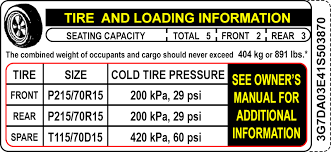Spare Tire Pressure
The spare tire, often overlooked and underappreciated, is an integral component of a vehicle's safety kit. It serves as the unsung hero, patiently waiting in the trunk or attached to the underside of your vehicle, ready to rescue you from the roadside in the event of a tire puncture or blowout. However, this vital component can only serve its purpose if it is maintained correctly, and a critical aspect of this maintenance is ensuring the spare tire has the correct pressure.
Before diving into the nuances of tire pressure, it's important to distinguish between the two main types of spare tires: full-size spares and compact, or "donut", spares. Full-size spares are identical to the regular tires on your vehicle and can be used as a direct replacement, while donut spares are smaller, lighter, and only meant for short-term use to get you to a repair shop. The pressure requirements can differ significantly between these types.
The importance of maintaining the correct pressure in your spare tire cannot be overstated. Overinflated or underinflated spare tires can lead to a host of problems. An overinflated spare can cause poor traction and a rough ride, while an underinflated tire can lead to increased rolling resistance, heat buildup, and even a blowout, particularly when the spare is a donut designed for limited use at reduced speeds.
Ideally, tire pressure, including that of the spare, should be checked monthly and before long trips. For accurate pressure readings, it's best to check tires when they are cold, as heat generated from driving can temporarily raise the pressure. It is recommended to use a reliable tire gauge and compare the readings with the manufacturer's recommended pressure levels, which can usually be found in the owner's manual or on a sticker inside the driver's door.

For compact, temporary spare tires (often called "donut" spares), the required pressure is usually much higher than for standard tires, often around 60 psi. However, this can vary, so it's crucial to look for the pressure recommendation printed on the sidewall of the spare tire itself or consult the vehicle's owner's manual.
Spare tire pressure can be affected by seasonal temperature changes. As a general rule, tires will lose or gain 1 PSI (pound per square inch) for every 10°F change in temperature. Therefore, spare tire pressure should be adjusted in the winter and summer months accordingly. Additionally, even when not in use, tires can lose pressure over time due to permeation - the natural process of air escaping through the tire's rubber compound. Thus, even an unused spare can become underinflated and require attention.
In the event of a flat tire, a properly inflated spare is crucial. It should be installed following the vehicle manufacturer's recommendations, with attention to the torque applied to the lug nuts. If using a donut spare, it is essential to adhere to the specific speed limit, which is usually around 50 mph, and to drive to the nearest service location without delay. Driving on a donut spare for extended periods or at high speeds can be dangerous.
Regularly checking and maintaining the correct pressure in your spare tire is a simple yet essential aspect of vehicle maintenance that promotes safety and peace of mind. It ensures that your spare tire is ready for action whenever you need it, preventing additional stress during the unexpected occurrence of a flat tire. As part of a comprehensive vehicle safety checklist, spare tire pressure deserves attention and care. By adhering to proper maintenance guidelines, drivers can extend the life of their spare and ensure it functions optimally in times of need.
All listed guides, data and/or calculations are for informational purposes only. Spare-Tires.com does not warrant or make any representations regarding the accuracy of or the results of the use of this information.